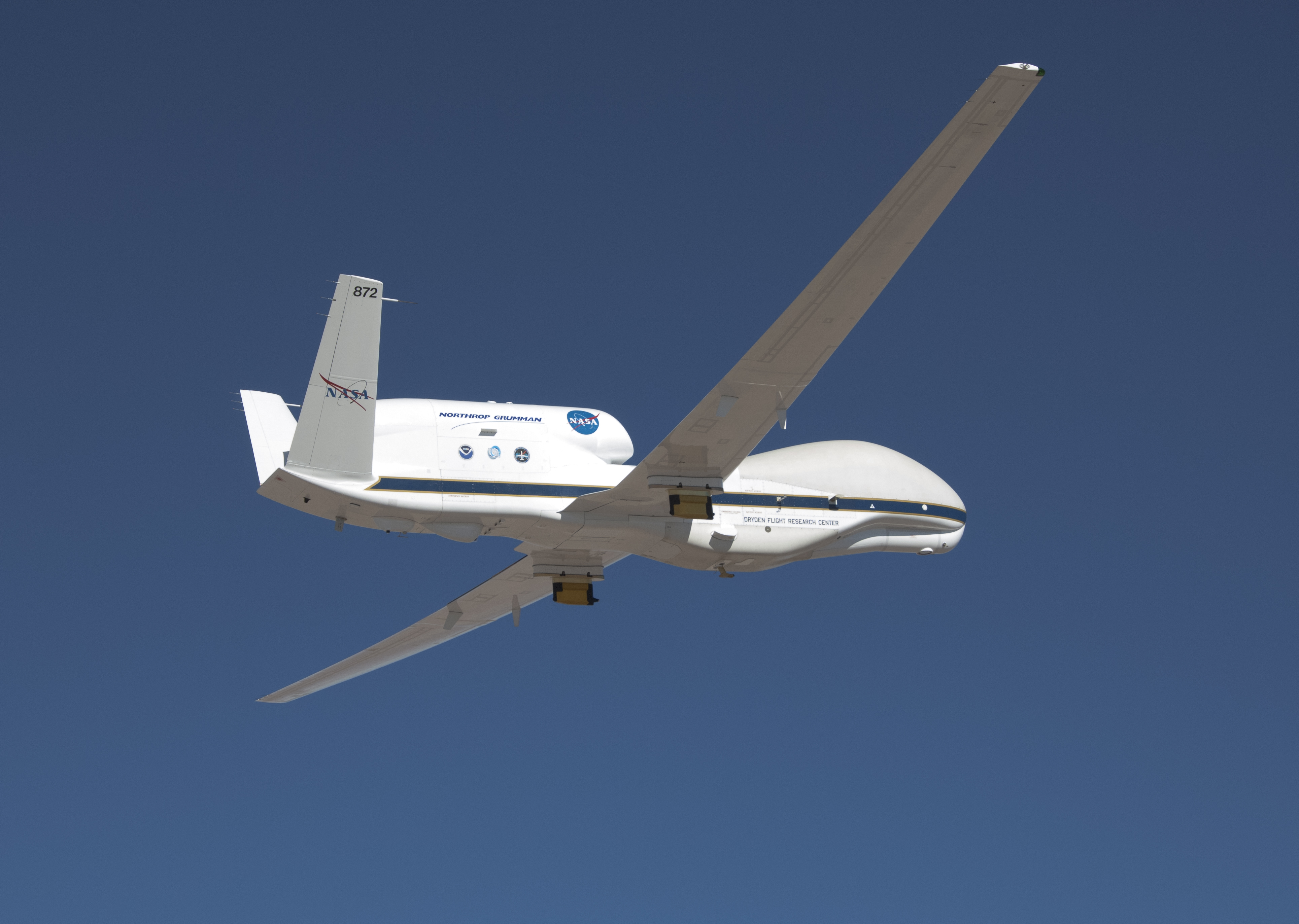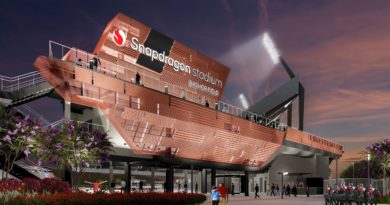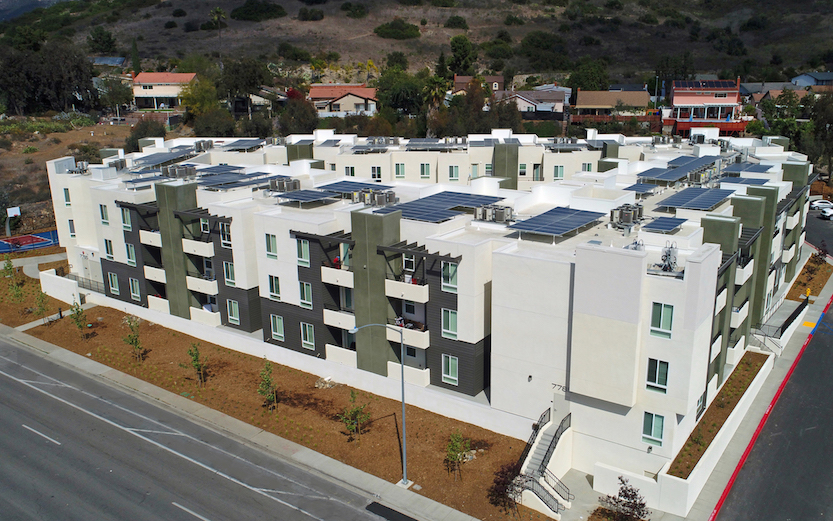Daily Business Report-Feb. 8, 2016
NASA Global Hawk in flight. (Courtesy Northrop Grumman)
NASA Global Hawk Studies Severe
El Nino Weather Over Pacific Ocean
The NASA Global Hawk built by Northrop Grumman Corp. in San Diego will conduct several missions to collect detailed data over the Pacific Ocean from complex El Niño weather patterns resulting from variations in ocean temperatures across the equator.
NASA Global Hawk missions will take place from February to March as part of National Oceanic and Atmospheric Administration (NOAA)-led missions.
The multi-year missions, called Sensing Hazards with Operational Unmanned Technology (SHOUT), will provide detailed meteorological measurements from a region in the Pacific that is known to be particularly critical for interactions linked to West Coast storms and rainfall.
“With the ability to fly at 65,000 feet for 30 hours, the NASA Global Hawk allows us to study intense and remote weather conditions that were previously unreachable,” said Dave Aguinaldo, program manager, NASA Global Hawk, Northrop Grumman.
The NASA Global Hawk is one of several assets being used by scientists from NASA and NOAA to advance understanding and predictions of tropical storms, winter storms and major floods. The unmanned high-altitude, long-endurance NASA Global Hawk aircraft will work alongside air, land and sea platforms to gather data. Scientists will use this information to better understand El Niño’s impacts on the U.S. and to improve NOAA’s observational systems, models and predictions.
NASA and Northrop Grumman are partnered under the Space Act Agreement, which allows for shared use of the NASA Global Hawk system to conduct scientific experiments and explore new mission capabilities. Previous NASA Global Hawk missions have included hurricane research, examining the effects of greenhouse gasses and conducting cutting-edge autonomous aerial refueling trials.
_____________________________________
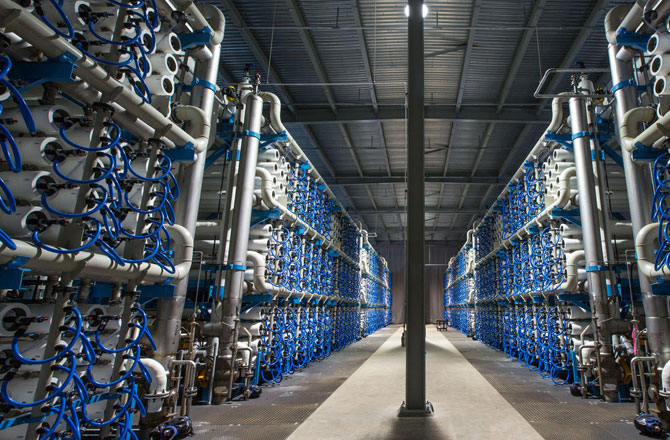
Water Authority Expects Desalination
Plant To Reduce Conservation Efforts
The San Diego County Water Authority is working with state regulators to certify the Carlsbad Desalination Plant as a drought-resilient local supply source that will reduce state-mandated water-use targets across the region.
Changes to the state’s emergency drought response regulation adopted last week by the State Water Resources Control Board provide a mechanism for the San Diego region to receive drought-resiliency benefits from the Carlsbad plant, which started commercial production in December 2015. With the plant now online, the Water Authority expects that state-mandated water-use targets for local water agencies will soon be lowered to align more closely with local water supply investments.
“The State Board’s decision is good news for our communities and ratepayers,” said Water Authority Board Chair Mark Weston. “These modifications recognize the need to take into account local water supply development efforts as well as increased conservation when implementing emergency drought response measures. Supplies from the Carlsbad desalination plant will reduce the need for extreme water conservation efforts in our region, an appropriate benefit for our proactive efforts to improve our water supply reliability by investing in the plant.”
Former Faulconer Aid Named
Executive Director of Lincoln Club
City News Service
Brian Pepin has been named executive director of the Lincoln Club of San Diego County. He replaces Ryan Clumpner, who will take on a consulting role.
Pepin moved over from the office of San Diego Mayor Kevin Faulconer, where he served as liaison to the City Council.
“Ryan has done an outstanding job during his two years with the Lincoln Club and we are very pleased that he will continue to serve as a strategic adviser to the club during 2016,” club Chairman Steve Quinn said. “We are also pleased and very fortunate to have engaged Brian Pepin, a professional with extensive experience in political campaigns and public policy, as our new executive director.”
Clumpner said the new structure will help the organization expand the scope and quality of its direct political action, and improve organizational development, member recruitment and events.
The Republican Lincoln Club has helped get several business-friendly politicians elected in recent years, including Faulconer.
NFL Commissioner: Keeping
Chargers in San Diego a Priority
City News Service
National Football League Commissioner Roger Goodell said Friday that keeping the Chargers in San Diego is a priority, and the league will do what it can to help build a new stadium for the team.
Speaking at his annual Super Bowl news conference, Goodell said neither San Diego nor Oakland has the “right kind of facilities” for the Chargers or Raiders, respectively.
“My pledge to Dean Spanos, to (Raiders owner) Mark Davis, to the mayor of Oakland and the mayor of San Diego is to do everything possible we can to support them, to try to get the right kind of facilities long term in both of those markets,” Goodell said.
“I think it’s great that Dean Spanos and his family said ‘we want to make this work in San Diego,”‘ Goodell said. “They have an incredibly attractive option in Los Angeles, but they decided they’re going to try to go and make this work in San Diego, and we’ll do everything we can to support that.”
The commissioner said that any deal for the Chargers and Raiders to remain in their current cities will have to work for both the teams and communities.
As part of the deal reached by team owners last month, the NFL will chip in an extra $100 million toward stadium construction costs in San Diego and Oakland, on top of the $200 million the league already pledges for such projects.
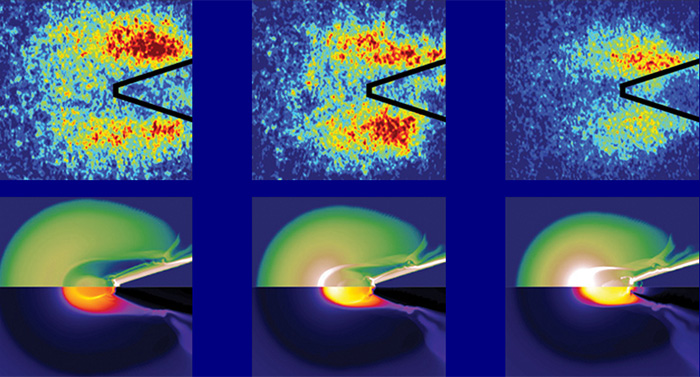
UCSD, General Atomics Researchers Come
Close to Achieving Controlled Nuclear Fusion
An international team of researchers has taken a step toward achieving controlled nuclear fusion — a process that powers the Sun and other stars, and has the potential to supply the world with limitless, clean energy.
The team, led by scientists and engineers at the University of California, San Diego and General Atomics, developed a new technique to “see” where energy is delivered during a process called fast ignition, which is an approach to initiate nuclear fusion reactions using a high-intensity laser. Visualizing the energy flow enabled researchers to test different ways to improve energy delivery to the fuel target in their experiments. The researchers published their findings online in the Jan. 11 issue of the journal Nature Physics.
Fast ignition involves two stages to start nuclear fusion. First, hundreds of lasers compress the fusion fuel (typically a mix of deuterium and tritium contained in a spherical plastic fuel capsule) to high density. Then, a high-intensity laser delivers energy to rapidly heat (ignite) the compressed fuel. Scientists consider fast ignition a promising approach toward controlled nuclear fusion because it requires less energy than other approaches.
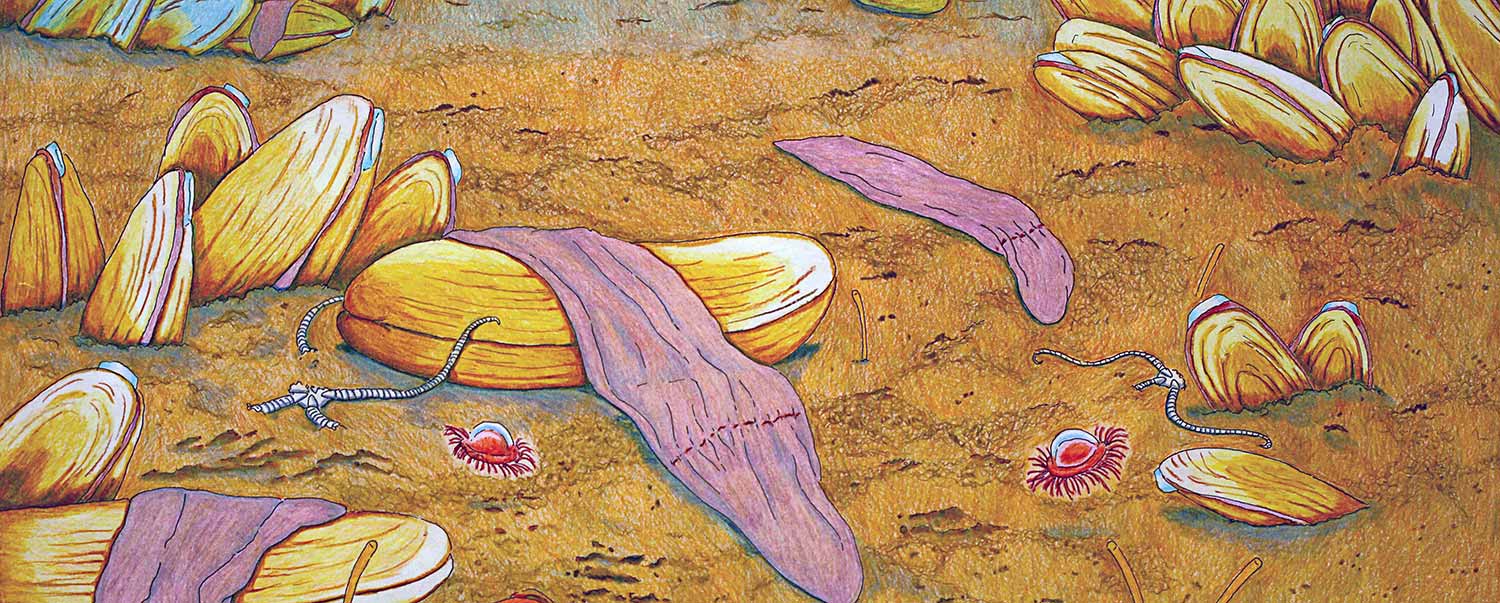
Scripps-Led Team Discovers
4 New Deep-Sea Worm Species
A pink flatworm-like animal known by a single species found in waters off Sweden has puzzled biologists for nearly six decades. New discoveries half a world away by a team of scientists from Scripps Institution of Oceanography, the Western Australian Museum and the Monterey Bay Aquarium Research Institute have helped properly identify these elusive creatures through genetic analysis.
In the Feb. 4 issue of the journal Nature, the researchers describe four newly discovered species living near deep-sea cold seeps, hydrothermal vents, and whale carcasses off the coasts of California and Mexico. The new discoveries have allowed the scientists to finally stabilize the placement of the five species, all in the genus Xenoturbella, on the animal tree of life.
The 10-centimeter (4-inch) long Xenoturbella churro, named for its resemblance to the popular fried-dough pastry, is one of four species recently discovered that lie near the base of the evolutionary tree of animals.
“The findings have implications for how we understand animal evolution,” said Scripps marine biologist Greg Rouse, the lead author of the study. “By placing Xenoturbella properly in the tree of life we can better understand early animal evolution.”
Climate Collaborative Receives $689,500
Grant for Protecting Region’s Coastline
The San Diego Regional Climate Collaborative, a partnership managed by seven San Diego public agencies, the University of San Diego, the San Diego Foundation and San Diego Gas & Electric, has received a $689,500 federal grant for coastal hazard protection and resilience.
The two-year grant from the National Oceanic and Atmospheric Administration will integrate activities and provide resources across all of the coastal cities but focus on the north-central coast of the county and Imperial Beach, where significant private residential, business, and infrastructure investments are threatened. The project will provide new data on flood mapping and shoreline bluff surveys, develop additional legal, economic and scientific expertise, and help cities with outreach and communication.
“This comprehensive strategy will result in implementable actions to reduce the San Diego region’s risks and vulnerabilities to coastal flooding, beach erosion and extreme weather events,” said Laura Engeman, the USD administrator who manages the Climate Collaborative.
The cities of Carlsbad and Del Mar are matching the grant with a combined $328,000 they received from the State of California to assist them with updating their local coastal plans to account for coastal storm and sea level rise hazards. The San Diego Foundation is also contributing a match of $80,000 supporting similar assessments in the cities of Encinitas, Oceanside, and San Diego.

County Vehicle Auction Begins Today
Bidding opens today in the county’s latest public vehicle auction. Surplus vehicles include automobiles, trucks, vans, SUVs, trailers, a school bus and an ambulance. Many bids start at $100.
Among the vehicles are a 2005 Toyota Prius Hybrid, family vans, Ford Taurus sedans, Ford Rangers and Ford Escapes.
Vehicles can be checked out in person. They will go on display from 9 a.m. to 5 p.m. on Feb. 13, and from 8 a.m. to noon on Feb. 15, at 369 Main St., Ramona, CA, 92065.
Bidding ends at noon on Monday, Feb. 15.
Visit TNT Public Auction to register to bid.
Council to Vote Today on Placing
Minimum Wage Hike on Ballot
The San Diego City Council is scheduled to vote today on placing a measure on the June ballot to increase the minimum wage and allow workers to earn up to five days of sick leave. Councilmember Todd Gloria initiated the legislation in 2014 and it was approved by the City Council later that year. A referendum forced the issue onto the next municipal election which will be held on June 7, 2016.
“While many cities around the nation have already raised their minimum wage, San Diego’s lowest paid workers have been delayed a wage increase and are continuing to face a rising cost of living and high housing prices,” said Gloria. “Over 172,000 San Diegans have waited for two years to get these raises that are necessary to help keep a roof over their heads and food on their tables. Today’s action will put this decision in the hands of voters who I believe will agree that this is a sensible increase and the right thing to do.”
The increase to $11.50 minimum wage would be phased in through 2017 with indexing to inflation starting on Jan. 1, 2019. The original proposal phased the wage increase to $9.75 on Jan. 1, 2015 and $10.50 on Jan. 1, 2016 before reaching $11.50 on Jan. 1, 2017. If approved in June, the $10.50 amount would be effective immediately upon certification of the election results. The proposal includes no exemptions for any industry or business.
Once-Beloved Balboa Park Theater
Is Now a Crumbling Eyesore
Voice of San Diego
When it debuted in 1935, the Starlight Bowl was a civic gem. The 3,500-seat outdoor venue, then known as the Ford Bowl, drew crowds to Balboa Park during the famed California Pacific International Exposition and in decades to come, countless rock concerts and plays.
Now it’s filled with weeds.
The shuttered Starlight, nestled in the heart of Balboa Park between the San Diego Air & Space Museum and the municipal gym, hasn’t hosted a show in at least five years. The facility needs millions of dollars in upgrades and fixes, according to one study. The theater also has lost its steward. The San Diego Civic Light Opera Association, the now-defunct nonprofit that had run the facility since 1946, walked away from its city lease last fall in the wake of a lawsuit alleging multiple contract violations
Read the full story here.
Personnel Announcements
Adam B. Levine Joins CaseyGerry Law Firm
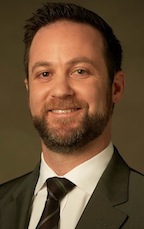
Adam B. Levine, previously a law clerk with the CaseyGerry firm in San Diego, has joined the firm as its newest attorney, specializing in serious personal injury and aviation litigation.
Levine is the son of the late Harvey Levine, a San Diego trial lawyer.
Prior to joining CaseyGerry, Levine worked as a federal judicial extern at the U.S. District Court for the Southern District of California for the Honorable Irma E. Gonzalez, as well as working for Levine & Miller — his father’s law firm. Prior to that, Levine worked in the field of architecture for 11 years, during which time he became a licensed architect in California.
Levine earned a Bachelor of Arts degree in architecture from University of California, Berkeley, a master’s degree in architecture and real estate development from Woodbury University, and a J.D., summa cum laude, from California Western School of Law.

